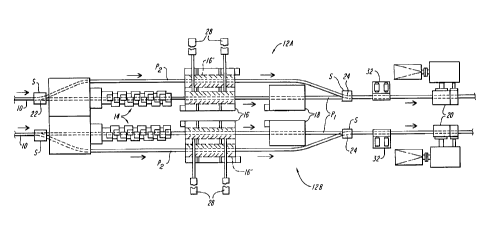Some of the information on this Web page has been provided by external sources. The Government of Canada is not responsible for the accuracy, reliability or currency of the information supplied by external sources. Users wishing to rely upon this information should consult directly with the source of the information. Content provided by external sources is not subject to official languages, privacy and accessibility requirements.
Any discrepancies in the text and image of the Claims and Abstract are due to differing posting times. Text of the Claims and Abstract are posted:
| (12) Patent: | (11) CA 2299784 |
|---|---|
| (54) English Title: | ROLLING MILL FINISHING SECTION |
| (54) French Title: | SECTION DE FINITION DE LAMINOIR |
| Status: | Deemed expired |
| (51) International Patent Classification (IPC): |
|
|---|---|
| (72) Inventors : |
|
| (73) Owners : |
|
| (71) Applicants : |
|
| (74) Agent: | FETHERSTONHAUGH & CO. |
| (74) Associate agent: | |
| (45) Issued: | 2004-06-29 |
| (22) Filed Date: | 2000-02-23 |
| (41) Open to Public Inspection: | 2000-09-11 |
| Examination requested: | 2000-02-23 |
| Availability of licence: | N/A |
| (25) Language of filing: | English |
| Patent Cooperation Treaty (PCT): | No |
|---|
| (30) Application Priority Data: | |||||||||
|---|---|---|---|---|---|---|---|---|---|
|
A method and apparatus for finish rolling long products such as bars, rods and the like, comprising: in a first operational mode, rolling the products through a finishing block and a reducing sizing mill arranged on a primary pass line; and in a second operational mode, diverting the products from the primary pass line to a secondary pass line bypassing the finishing block and then back to the primary pass line for rolling in the reducing sizing mill. Optionally and preferably, a cooling unit is shifted between the primary and secondary pass lines to cool products being rolled in each operational mode.
Procédé et appareil pour le laminage de finition de produits longs tels que des barres, des tiges ou autre, comprenant : selon un premier mode de fonctionnement, laminer les produits dans une cage de finition et un calibreur-réducteur disposé dans un ensemble de première passe; et selon un deuxième mode de fonctionnement, dévier les produits de l'ensemble de première passe vers un ensemble de deuxième passe, évitant la cage de finition, et ensuite retourner vers l'ensemble de première passe pour le laminage dans le calibreur-réducteur. Optionnellement et préférablement, une unité de refroidissement est intercalée entre les ensembles de première et seconde passe pour refroidir les produits laminés selon chaque mode de fonctionnement.
Note: Claims are shown in the official language in which they were submitted.
Note: Descriptions are shown in the official language in which they were submitted.

For a clearer understanding of the status of the application/patent presented on this page, the site Disclaimer , as well as the definitions for Patent , Administrative Status , Maintenance Fee and Payment History should be consulted.
| Title | Date |
|---|---|
| Forecasted Issue Date | 2004-06-29 |
| (22) Filed | 2000-02-23 |
| Examination Requested | 2000-02-23 |
| (41) Open to Public Inspection | 2000-09-11 |
| (45) Issued | 2004-06-29 |
| Deemed Expired | 2015-02-23 |
There is no abandonment history.
| Fee Type | Anniversary Year | Due Date | Amount Paid | Paid Date |
|---|---|---|---|---|
| Request for Examination | $400.00 | 2000-02-23 | ||
| Registration of a document - section 124 | $100.00 | 2000-02-23 | ||
| Application Fee | $300.00 | 2000-02-23 | ||
| Maintenance Fee - Application - New Act | 2 | 2002-02-25 | $100.00 | 2002-02-05 |
| Maintenance Fee - Application - New Act | 3 | 2003-02-24 | $100.00 | 2003-01-31 |
| Maintenance Fee - Application - New Act | 4 | 2004-02-23 | $100.00 | 2003-11-07 |
| Final Fee | $300.00 | 2004-04-16 | ||
| Maintenance Fee - Patent - New Act | 5 | 2005-02-23 | $200.00 | 2005-02-02 |
| Maintenance Fee - Patent - New Act | 6 | 2006-02-23 | $200.00 | 2006-01-30 |
| Maintenance Fee - Patent - New Act | 7 | 2007-02-23 | $200.00 | 2007-01-30 |
| Maintenance Fee - Patent - New Act | 8 | 2008-02-25 | $200.00 | 2008-01-30 |
| Maintenance Fee - Patent - New Act | 9 | 2009-02-23 | $200.00 | 2009-01-30 |
| Maintenance Fee - Patent - New Act | 10 | 2010-02-23 | $250.00 | 2010-01-08 |
| Registration of a document - section 124 | $100.00 | 2010-07-13 | ||
| Maintenance Fee - Patent - New Act | 11 | 2011-02-23 | $250.00 | 2011-01-19 |
| Maintenance Fee - Patent - New Act | 12 | 2012-02-23 | $250.00 | 2012-01-10 |
| Maintenance Fee - Patent - New Act | 13 | 2013-02-25 | $250.00 | 2013-01-17 |
Note: Records showing the ownership history in alphabetical order.
| Current Owners on Record |
|---|
| SIEMENS INDUSTRY, INC. |
| Past Owners on Record |
|---|
| MORGAN CONSTRUCTION COMPANY |
| SHORE, T. MICHAEL |